Stereopsis Demonstrations
in Chapter Eight of Perception, 4th Edition
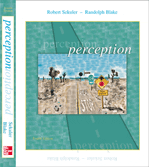
Chapter Eight in the 4th
edition of Sekuler and Blake's Perception (2001, McGraw Hill)
includes several demonstration "stereograms" to be viewed
by crossing the eyes or by diverging the eyes ("free fusion"
as the technique is called). Some people find this hard to do,
and the technique makes it impossible simply to reverse the sign
of the disparity. On this webpage we have reproduced several of
those demonstration stereograms as anaglyphs, i.e., red/green
images to be viewed using inexpensive red/green glasses. Inexpensive
pairs of these glasses can be obtained from Reel
3D.
These demo anaglyphs were
designed to be viewed with the red lens in front of the right
eye and the green lens in front of the left eye. Switching the
glasses will reverse the sign of the disparity (making objects
that appear in the foreground now appear in the background).

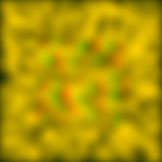
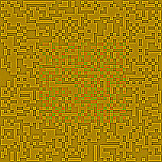
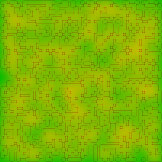 Figure 8.14 (a
- d)
In this figure
a central "square" stands out from the surrounding background
in all but the right-hand figure. The left-hand figure is the
original image, the middle two are spatial frequency filtered
versions of the original (low spatial frequencies only and high
spatial frequencies only). The image on the right presents the
low frequency image to one eye and the high frequency image to
the other (making it impossible to see depth).
Figure 8.14 (a
- d)
In this figure
a central "square" stands out from the surrounding background
in all but the right-hand figure. The left-hand figure is the
original image, the middle two are spatial frequency filtered
versions of the original (low spatial frequencies only and high
spatial frequencies only). The image on the right presents the
low frequency image to one eye and the high frequency image to
the other (making it impossible to see depth).
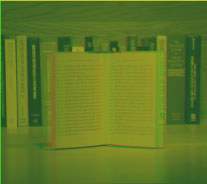 Figure 8.15
A real-world scene.
Compare the slight differences between left and right eye views
by looking just through the red lens and just through the green
lens. Notice how slightly different portions of the background
are occluded in the two eyes' views.
Figure 8.15
A real-world scene.
Compare the slight differences between left and right eye views
by looking just through the red lens and just through the green
lens. Notice how slightly different portions of the background
are occluded in the two eyes' views.
 Figure 8.20
Viewed with the
red lens in front of the right eye, this anaglyph produces the
impression of a grey disk located behind an opaque surface with
a 'cross-shaped' aperture cut into it. With the glasses reversed
(green in front of the right eye), one now sees a complete disk
standing in front of a white cross. Notice the appearance of transparency
where the disk "occludes" the dark background.
Figure 8.20
Viewed with the
red lens in front of the right eye, this anaglyph produces the
impression of a grey disk located behind an opaque surface with
a 'cross-shaped' aperture cut into it. With the glasses reversed
(green in front of the right eye), one now sees a complete disk
standing in front of a white cross. Notice the appearance of transparency
where the disk "occludes" the dark background.
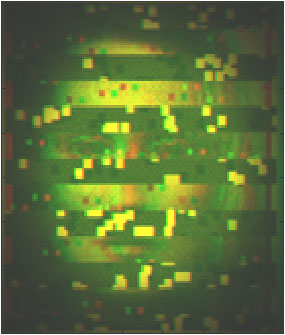 Figure 8.37
With the red lens
in front of the right eye, one easily sees a woman's face partially
occluded by textured, horizontal stripes. With the glasses reversed,
the visible portions of the woman's face now stand out in front
of the textured horizontal stripes; an experiment by Nakayama
et al (discussed in the text) shows that this unusual configuration
makes it more difficult to recognize the face.
Figure 8.37
With the red lens
in front of the right eye, one easily sees a woman's face partially
occluded by textured, horizontal stripes. With the glasses reversed,
the visible portions of the woman's face now stand out in front
of the textured horizontal stripes; an experiment by Nakayama
et al (discussed in the text) shows that this unusual configuration
makes it more difficult to recognize the face.
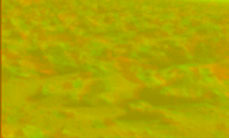 Box 8.2
Box 8.2
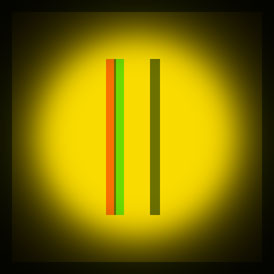 Box 8.2
The upper image
comes from a photograph of the surface of Mars; the lower image
is a simple line stereogram in which one vertical bar appears
a little closer to the viewer than the other bar.
Box 8.2
The upper image
comes from a photograph of the surface of Mars; the lower image
is a simple line stereogram in which one vertical bar appears
a little closer to the viewer than the other bar.
Chapter Eight
also discusses binocular rivalry, the breakdown in stable binocular
vision when the two eyes view radically different images (see
Box 8.3). Below are a few anaglyphs that produce conditions yielding
binocular rivalry, and more examples appear at this
website.
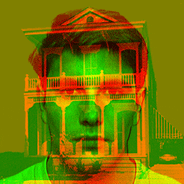
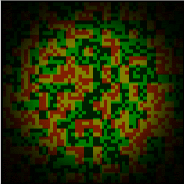 The image on the
left is a rival target created by Frank
Tong (currently at Princeton University but moving to Vanderbilt in Fall, 2004) and used in his fMRI study of binocular rivalry (Tong,
F., Nakayama, K., Vaughan, J.T. & Kanwisher, N. 1998. Binocular
rivalry and visual awareness in human extrastriate cortex. Neuron
21, 753-759). The image on the right is a computer-generated
rival target that presents different sized checks to the two eyes.
The image on the
left is a rival target created by Frank
Tong (currently at Princeton University but moving to Vanderbilt in Fall, 2004) and used in his fMRI study of binocular rivalry (Tong,
F., Nakayama, K., Vaughan, J.T. & Kanwisher, N. 1998. Binocular
rivalry and visual awareness in human extrastriate cortex. Neuron
21, 753-759). The image on the right is a computer-generated
rival target that presents different sized checks to the two eyes.
Created by
R. Blake
Last modified 11/12/2003












